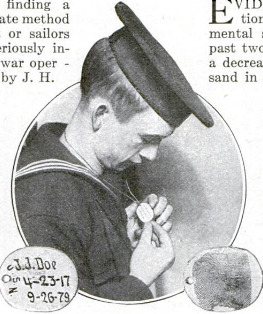Identification tag
Contenuto
-
Titolo
-
Identification tag
-
Article Title and/or Image Caption
-
Identification Tag of Indestructible Metal for Naval Men
-
Caption: This naval identification tag only melts in the most intense heat and is not corroded
by salt water, being of Monel metal
-
extracted text
-
THE difficulty of finding a
simple and adequate method
of identifying soldiers or sailors
who are killed or seriously in-
jured in the course of war oper -
tions, has been solved by J. H.
Taylor, of Alexandria,
Va., by the invention
of an identification
tag which was adopted
by the U. S. Navy
Department on May
12, 1917. The tag,
which is considered
the best in use in any
country in the world,
consists of a plate of
Monel metal,
which does not melt
below a tempera-
ture of 3840 de-
grees Fahrenheit
and is not corroded
by salt water. The
name of the bearer
and other data are written with diluted
printer’s ink on .one side of the tag, while a
rolled impression of the bearer’s right in-
dex finger is placed on the opposite side.
The tag is then dipped in asphaltum and
the superfluous asphaltum removed with a
fine brush, after which it is heated until
the ink on both sides is glossy. After
cooling the tag is deposited in a nitric
hydrochloric acid bath which etches the
surface of the
metal not cov-
ered by ink.
By means of a
string or chain
passed through
a hole in it the
completed disk
is carried
around the
neck of the
‘wearer upon all
occasions, in
the same man-
ner as a charm,
for it takes up
no room and is
put on and
forgotten.
-
Lingua
-
eng
-
Data di rilascio
-
1918-03
-
pagine
-
379
-
Diritti
-
Public Domain (Google digitized)
-
Archived by
-
Filippo Valle
-
Alberto Bordignon (Supervisor)


